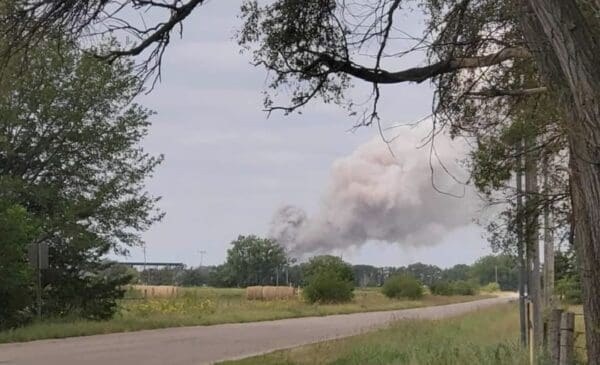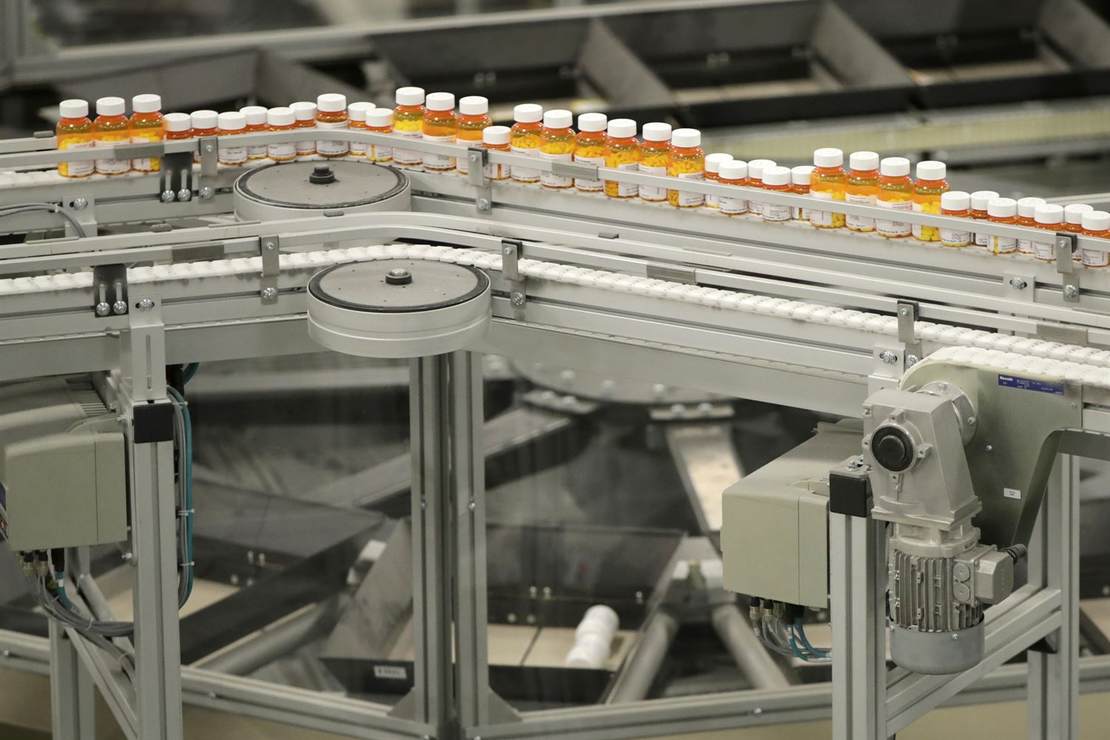
A train car carrying the hazardous chemical perchloric acid exploded today in Union Pacific Railroad’s Bailey Yard in North Platte, Nebraska, setting off a massive evacuation order covering a four-mile radius, Daily Mail reported.
The North Platte Volunteer Fire Department issued an urgent evacuation notice via social media, stating: “Emergency evacuation for the area between Splinter and Front North of railroad track due fire at the railroad involving heavy toxic smoke.”
The post went on to say that the explosion happened at approximately 12:10 pm local time. A subsequent message warned that additional residences should prepare for evacuation due to changing wind and weather conditions.
Emergency evacuation for the area between splinter and front North of railroad track due fire at the railroad involving heavy toxic smoke
Explosion at Union Pacific Railroad Bailey Yards at approximately 12:10 pm. #hazmat #Northplatte #Nebraska pic.twitter.com/zxJWkw2BE5
— North Platte VFD (@NPVFD69101) September 14, 2023
HOUSES BETWEEN HOMESTEAD AND FRONT, AND BETWEEN HWY 30 AND WEST A , BE PREPARED TO EVACUATED IN THE NEXT ONE TO TWO HOURS DUE TO WIND AND WEATHER CHANGING.#Northplatte #Nebraska #hazmat pic.twitter.com/TIu2pR00cn
— North Platte VFD (@NPVFD69101) September 14, 2023
The Nebraska State Patrol also released an official statement, saying, “Emergency crews are on the scene of a railcar fire between North Platte and Hershey.
Emergency crews are on the scene of a railcar fire between North Platte and Hershey.
Anyone located between Front Road and Splinter Road, from Highway 30 to 1 mile north, is asked to evacuate the area.
Highway 30 is CLOSED in the area at this time. I-80 is not affected. pic.twitter.com/079oUc7BMN
— Nebraska State Patrol (@NEStatePatrol) September 14, 2023
Videos shared on social media captured a sky enveloped in toxic fumes. An emergency SMS notification was sent out, alerting the local population to the imminent danger and advising them to evacuate.
#BREAKING: A Four Mile Evacuation has been Ordered after a Railcar carrying toxic chemicals explodes Unleashing Hazardous Toxic Smoke
Currently Numerous Authorities and hazmat crews are one the scene of the Union Pacific Railroad tracks in North… pic.twitter.com/dHbcGkY6n6
— R A W S A L E R T S (@rawsalerts) September 14, 2023
Although most of the evacuation zone appears to be farmland, officials continue to monitor the situation. The latest update from Nebraska’s Emergency Management indicated that the situation had been contained.
“Update on Railcar Fire. NP Fire/Hazmat are on scene w/UPRR. The incident is contained. They are monitoring the situation & wx, adjusting their tactics & evacuations to keep responders & citizens safe. Changes will be put out on media, social media, & RAVE Alerts. Avoid the area,” according to Region 51 Emergency Management in Nebraska.
Update on Railcar Fire. NP Fire/Hazmat are on scene w/UPRR. The incident is contained. They are monitoring the situation & wx, adjusting their tactics & evacuations to keep responders & citizens safe. Changes will be put out on media, social media, & RAVE Alerts. Avoid the area.
— lincoemgt (@lincoemgt) September 14, 2023
In another post, the management said that the evacuation order for the rail car incident has been lifted!
The evacuation order for the rail car incident has been lifted! Hwy 30 is open. Thank you all for your cooperation today!
— lincoemgt (@lincoemgt) September 14, 2023
According to the North Platte Telegraph, two local men agreed that they heard a total of four explosions.
“It just shook the ground,” Charlie Morland said. “You could feel it shake the vehicles and stuff. I knew it was a pretty violent explosion.”
The other man, a retired railroader said, “It shook our house pretty good.”
Local resident Gregg Robertson described the horrific scene: “I just saw something and I looked and it was just a big ball of flame. And then it was just fire, fire, fire, constant for 10, 12 minutes maybe. And then the fire went down and smoke kind of increased, and then it was just sparks coming out.”
Robertson also noted the unusual coloration of the smoke plumes. “The east plume was like black smoke. The west plume was orange smoke, something like I’ve not seen from a fire,” he added.
Union Pacific Railroad confirmed to the Daily Mail that the explosion occurred within a container, causing several railcars to catch fire. Importantly, the railcar had not derailed and had been stationary in the yard for several hours before the incident. The company reassured the public that no personnel were injured in the blast.
The cause of the fire is not known at this time.
Perchloric acid is a mineral acid that is stronger than sulfuric acid, nitric acid, and hydrochloric acid. It is used to prepare perchlorate salts, including ammonium perchlorate, which is a component of rocket fuel.
From the University of Illinois:
Perchloric acid is one of the strongest acids known. At room temperature, aqueous solutions up to 72% do not have significant oxidizing power, and the corrosive properties are very similar to other mineral acids. However, the oxidizing power increases with concentration and temperature. Concentrated perchloric acid (72%) heated above 150⁰C is a strong oxidizer, and reacts violently with organic material, which has resulted in devastating explosions in the past.
The monohydrate of perchloric acid (85%) is a good oxidizer at room temperature.
Anhydrous perchloric acid is highly unstable, explodes upon contact with organic material, and explodes spontaneously at room temperature after storage for a few days. Its preparation should be avoided.
Perchloric acid forms an azeotrope with water at a concentration of 72.5% perchloric acid. Therefore, aqueous solutions do not form anhydrous perchloric acid by evaporation. However, dangerous anhydrous perchloric acid can form when an aqueous solution is subjected to strong dehydrating conditions such as exposure to concentrated sulfuric acid, acetic anhydride, or phosphorous pentoxide.
At elevated temperatures, vapors from perchloric acid can condense on surfaces in the ductwork of the hood, where they form perchlorate salts that are often highly shock-sensitive and that pose a serious explosion hazard.
Perchloric acid reacts with alcohols and certain other organic compounds to form highly unstable and explosive perchlorate esters.
Safe Handling
- Wear appropriate Personal Protective Equipment (lab coat, safety glasses, and acid-resistant gloves) when handling perchloric acid.
- Do not handle perchloric acid on a wooden surface, and do not let it come into contact with oxidizable materials such as cloths, paper towels, or grease. Such materials can become highly flammable and may ignite spontaneously or even explode after absorbing perchloric acid liquid or vapor.
- Do not subject perchloric acid to strong dehydrating conditions.
- Dilute by adding perchloric acid to water, not by adding water to acid.
- If solutions containing perchloric acid are filtered through a paper filter, the filter (and precipitate) should be washed thoroughly with water to remove all perchlorate before being allowed to dry.
- Do NOT mix concentrated perchloric acid (>72%) with organic chemicals if temperatures could rise above ambient levels.
- Perchloric acid digestions and other uses at elevated temperatures require that the procedures be conducted in a specially designed fume hood with a water wash-down system. This system is required to prevent the buildup of explosive perchlorates in the ductwork.
- Do not heat perchloric acid in an oil bath. Use a sand bath, a heating mantle, or a hot plate.
If you know of or suspect that perchloric acid digestions have been performed in a fume hood not specifically designed for perchloric acid, inform Facilities and Services about the location of the hood.
Emergencies Procedures
Accidental Exposure
Skin Contact
Rinse off affected skin immediately with copious amounts of water for about 15 min; if necessary, use the safety shower. Remove contaminated clothing.
Eye Contact
Use the eye wash to rinse the eye thoroughly for at least 15 min, occasionally lifting upper and lower eyelids and rolling the eyeballs.
Inhalation
Move into fresh air immediately.
Ingestion
Do not induce vomiting. Rinse mouth with water.
If any symptoms persist after following first aid procedures, seek medical attention immediately. Provide the medical team with the Safety Data Sheet (SDS) for perchloric acid.
Spills
Spills of perchloric acid must be cleaned up thoroughly; dried acid residues can cause unexpected explosions in the future. The spill should be neutralized immediately with sodium bicarbonate or other inorganic acid neutralizer. Sweep up the neutralized spill with a non-flammable material and then clean the spill area thoroughly with water.
Do NOT use rags, paper towels, or sawdust to soak up perchloric acid spills. Such materials may spontaneously ignite once dried out. Likewise, spills on wood may present a fire hazard after the liquid dries.
In the event of a fire, the best extinguishing agent is water.
Storage
Store perchloric acid with other inorganic acids and away from organic chemicals and reducers, especially alcohols, glycerol, and hypophosphites. The containers should be stored in secondary containment preferably made from glass, porcelain, ceramic, or other non-absorbing, non-combustible material.
Limit stored quantities to what is needed for the next 6-12 months; do not store perchloric acid over extended periods of time.
Dispose of bottles with discolored perchloric acid solutions immediately.
Inform DRS if crystals have formed around the neck and cap of the bottle.
Disposal
Collect all perchloric acid and contaminated waste and dispose of it through DRS. The UI codes are 587 for perchloric acid and 50043 for debris contaminated with perchloric acid.



